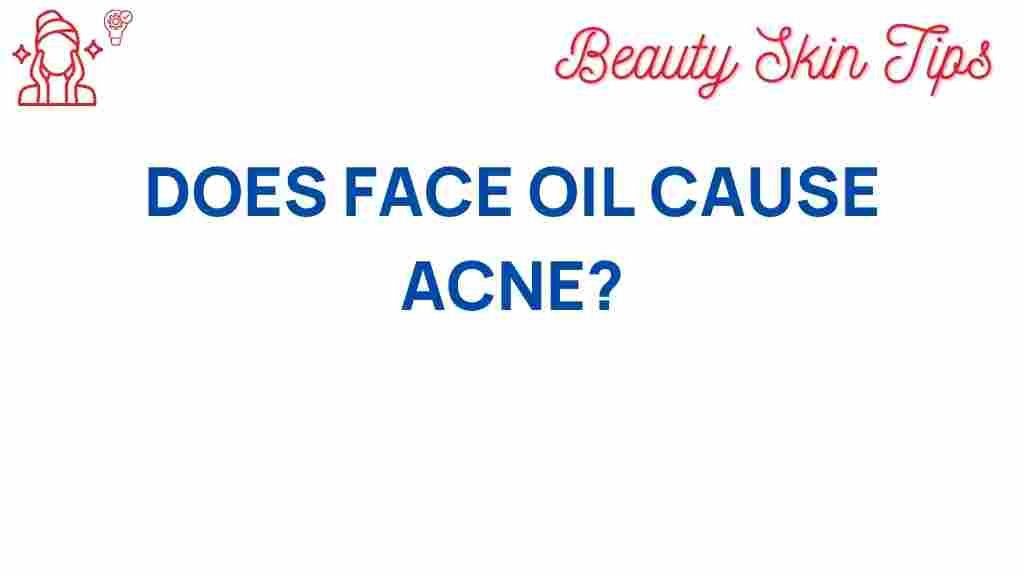The Truth About Face Oil: Can It Really Cause Acne?
In the world of skincare, face oils have garnered significant attention and popularity. Many individuals swear by their benefits, claiming they provide hydration, balance, and a healthy glow. However, a common concern persists: can face oil really cause acne? This article aims to dissect the myths and truths surrounding the use of face oils, helping you make informed decisions about your skincare routine.
Understanding Face Oils
Face oils are concentrated plant-based oils that can offer various benefits to your skin. They are often rich in essential fatty acids, vitamins, and antioxidants. Common types of face oils include:
- Argan Oil: Known for its moisturizing properties and rich in vitamin E.
- Jojoba Oil: Mimics the skin’s natural sebum and is non-comedogenic.
- Rosehip Oil: Excellent for brightening and reducing signs of aging.
- Tea Tree Oil: Renowned for its antibacterial properties, often used for acne-prone skin.
Choosing the right face oil is crucial, especially if you are prone to breakouts. Understanding how these oils interact with your skin can help you avoid potential issues.
How Face Oils Work
Face oils work by creating a barrier on the skin’s surface to lock in moisture, offering hydration and nourishment. They can also help balance oil production and maintain the skin’s natural moisture barrier. When used correctly, face oils can:
- Hydrate dry skin
- Improve skin texture
- Reduce the appearance of fine lines
- Enhance glow and radiance
However, the effectiveness of face oils depends on skin type and the formulation of the oil. Not all oils are suitable for everyone, particularly those with oily or acne-prone skin.
Can Face Oil Cause Acne?
One of the most frequently asked questions about face oils is whether they can lead to acne breakouts. The answer is not straightforward and depends on various factors:
1. Skin Type Matters
Your skin type plays a crucial role in how face oils affect you. For example:
- Oily Skin: If you have oily skin, using heavy or greasy oils can clog pores, potentially leading to breakouts.
- Dry Skin: Those with dry skin may find face oils beneficial as they provide much-needed moisture without causing breakouts.
- Combination Skin: Individuals with combination skin should choose lightweight oils and apply them selectively.
2. Comedogenic Rating of Oils
Not all oils are created equal when it comes to their tendency to clog pores. The comedogenic rating system helps classify oils based on their likelihood of causing acne:
- 0: Non-comedogenic (unlikely to clog pores)
- 1: Very low likelihood of clogging pores
- 2: Low likelihood of clogging pores
- 3: Moderate likelihood of clogging pores
- 4: High likelihood of clogging pores
- 5: Very high likelihood of clogging pores
For acne-prone skin, it is advisable to choose oils with a comedogenic rating of 0-2, such as jojoba oil or argan oil, while avoiding those with higher ratings.
3. Product Quality and Ingredients
The quality and formulation of the face oil are vital considerations. Always opt for high-quality, cold-pressed oils that are free from synthetic additives, fragrances, and fillers. Ingredients like essential oils can be beneficial but may cause irritation for some, particularly in sensitive skin types.
Step-by-Step Guide to Using Face Oil
To maximize the benefits of face oil while minimizing the risk of acne, follow these steps:
Step 1: Cleanse Your Face
Begin with a gentle cleanser to remove dirt, makeup, and excess oil from your skin. This prepares your skin for better absorption of the face oil.
Step 2: Apply a Toner (Optional)
If you use a toner, apply it after cleansing. A hydrating toner can help balance your skin’s pH and enhance moisture retention.
Step 3: Use a Serum
If you use a serum, apply it before the face oil. Serums are concentrated treatments that can address specific skin concerns, such as acne or aging.
Step 4: Apply Face Oil
Take a few drops of face oil and warm it between your palms. Gently press the oil onto your face, focusing on areas that feel dry or tight. Avoid using too much—less is often more.
Step 5: Moisturize
For those with dry skin, follow up with a moisturizer to seal in the hydration. Those with oily skin may skip this step or use a lightweight moisturizer.
Troubleshooting: What If You Experience Breakouts?
If you use face oil and notice an increase in breakouts, consider the following troubleshooting tips:
- Stop Using the Oil: Temporarily discontinue use to see if your skin improves.
- Switch Oils: Experiment with different oils that have a lower comedogenic rating.
- Patch Test: Always perform a patch test when trying a new product to monitor for adverse reactions.
- Consult a Dermatologist: If breakouts persist, seek professional advice to determine the underlying cause.
Conclusion
Face oil can be a valuable addition to your skincare routine, offering numerous benefits when used correctly. While it can potentially cause acne for some individuals, understanding your skin type, choosing the right oil, and following a proper application process can help mitigate these risks. Always listen to your skin and adjust your routine as necessary.
For more information on skincare and acne prevention, check out this helpful resource on acne management.
Ultimately, the truth about face oil is not that it universally causes acne, but rather that it requires careful consideration and selection based on individual skin needs. Enjoy exploring the world of face oils, and may your skin thrive!
This article is in the category Skincare and created by BeautySkinTips Team
